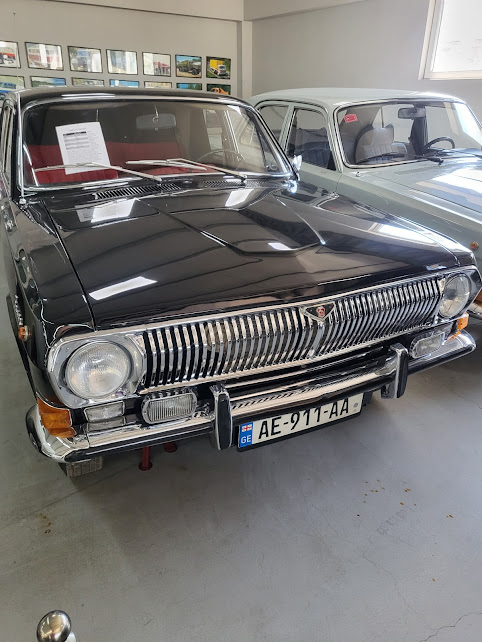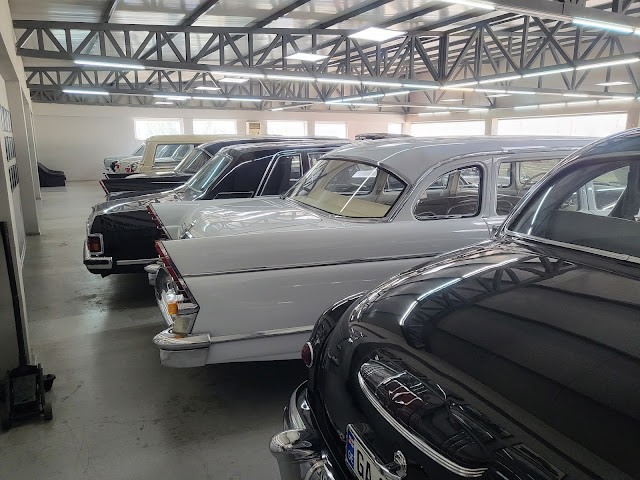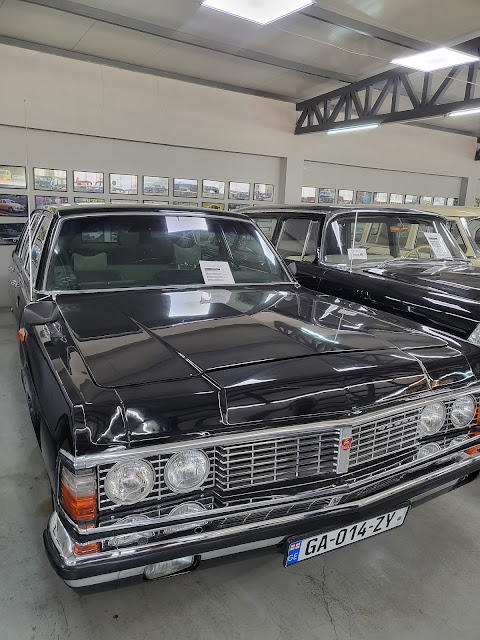Sharp-eyed readers would have already guessed from the Soviet Era Volga sedans shown above that we're not visiting a car collection in, say, Atlanta, even without the "Tbilisi Automuseum" lettering on the building, not to mention the illegible (to most of us) lettering above it. And indeed, this car collection is housed in the Republic of Georgia, a democratically-governed nation facing West (in a couple of senses) across the Black Sea, and with a high scenic view to area ratio...
It's a country traversed by picture-postcard mountain ranges with lakes nestling in green valleys. Our count on the mountain ranges is 10, but if you count the Greater and Lesser Caucasus separately from the Caucasus we're at a dozen...
Mountains provide a backdrop for this GAZ-20 Pobeda (Russian for "victory") four-door cabrio. The Pobeda was the first post-WWII Russian car design that was not a copy of a foreign design. After a couple dozen handbuilt prototypes appeared in 1946 and early production cars suffered problems with body integrity in 1948, the Gorky Automobile Works (GAZ) revised the 2.1 liter, side-valve 4-cylinder car, the first Soviet car with 4-wheel hydraulic brakes, and one of the first anywhere with flush-sided pontoon bodywork, and it stayed in production into 1958. Most Pobedas were sedans; about 14,000 cabrios were produced from 1949 to '53 owing to short supply of steel roof stampings.
The Pobeda cabrio appears to have delighted our volunteer photography crew*, but we're not sure if they were permitted to drive it off the premises...
The successor to the Pobeda, the GAZ-21 Volga, was introduced in 1956 and overlapped Pobeda production. In the same size category, it was designed with a 2.4 liter OHV inline 4, but the first thousand cars feathred the flathead Pobeda. Another independent design, the Volga reflected a bit of Ford influence in its styling, and an automatic transmission based on the Ford-O-Matic was offered. Its 106" wheelbase was 4" more than the Volvo Amazon (Type 122) that appeared the same year.
The Volga enjoyed a similar reputation for sturdy durability as that Volvo model, and was one of the first Russian cars to be exported in significant numbers...
For those reasons the GAZ-21 Volga had a long production life, and wasn't replaced by the 2.45 liter, aluminum-block 4-cylinder GAZ-24 Volga until 1970; a wagon appeared in 1971. Wheelbase increased to 110", the new car was shorter, lower and more space efficient, with room for 6. This design was successful enough that Belgian-assembled models were sold as the Scaldia Volga M24, with the final facelifted Volga M2410 available from 1985 to 1992, the year after the Soviet Union officially dissolved...
Before these original designs appeared, however, Russian car manufacturing depended upon foreign designs. If the GAZ 4 pickup below reminds you of a Ford Model A, there's a good reason. A 1932 agreement between the Soviet goverment and Ford Motor Company licensed use of Ford's designs. The Tbiiisi museum's restored GAZ 4 is one of less than half a dozen that remain. The museum also has a Ford Model A wagon as a reference car.
This GAZ M-1 went into production in 1936, and was based on the design of the Ford Model B from 1932, the transitional 4-cylinder model between the Model A and the more famous '32 Ford V8. The first version of the M-1 ("M" standing for a factory named for Molotov, of cocktail fame) used a side-valve V8 engine based upon drawings supplied by Ford. The second series had a more rounded grille shape, and an engine based upon the 6-cylinder Dodge D5. This particular 1st series M-1 was the personal car for Lavrenti Beria, enforcer of Stalin's purges as head of the dreaded NKVD...
When the Moscow Small Car Plant sought a design for a smaller postwar car than the Pobeda then in the works, it looked to GM's Opel Division in Germany, and adapted the Kadett K38 series for this Moskvitch 401 series that went into production at the end of 1946...
The Moskvitch 400 and 401 were replaced by the restyled 407 in 1956, and the new car featrured improvements like independent front suspension, a better heater and available radio. Even though private automobile ownership was not yet widespread in the Soviet Union, the Moskvitch 407 scored some success in export markets in Scandinavia and Eastern Bloc countries, competing with cars like the Fiat 1100 and Hillman Minx, which it resembled...
The restyled Moskvitch 408 prototype appeared in 1960, with the 408 and 412 series production cars running from 1964 to 1975. Power was provided by a 1.4 liter inline 4 gasoline engine, or a 1.7 liter diesel 4. Styling and size resembled the contemporary English Ford Cortinas, but as with the Volga designs, the Sixties Moskvitch was a homegrown effort.
The need for a more modern product led to a Soviet deal with Fiat. In exchange for Russian steel used in its Italian plants, Fiat would license production of a modified version of its 124 sedan (new in 1966) at the new Togiatti plant in Russia's Samara region. The plant and related new town were named for Italy's Communist Party leader. The car, known as the Zhiguli in Russia and Lada in export markets, was powered by a Russian-designed OHC inline 4 of 1,200 or 1,300cc, and offered thicker sheet steel in the bodywork, along with aluminum drum rear brakes instead of the Fiat discs. It was produced in Russia from 1970 until 2012, and was the second most-produced car model after the original VW Beetle, with over 17 million examples hitting the highways of Europe and Asia...
Special police versions included two series of Wankel-powered Zhiguli-Ladas, but these suffered the same durability problems as the NSU Wankels...
The Ukrainian Zapororzhets ZAZ-965 & 965A production spanned the Sixties, starting with a Fiat 600-influenced sedan shown below in '60. It wasn't a Fiat copy though; the rear-mounted engine was an air-cooled V4 rather than a inline water-cooled unit, and early cars had magnesiium blocks. Engine size went from just under 750cc to just under 900cc during this period.
The 965A was succeeded by the 1.2 liter V4 Model 966 in 1966, but production of the two models overlapped for 3 years. The new model, with its Corvair-influenced styling, had a longer production life span than the Corvair (or most cars really), with production ending in 1994, and exports going from Ukraine to Western Europe and Scandinavia, with some cars being sold with Renault power plants instead of the air-cooled V4...
The SMZ S-3D was classed as a "cyclecar" and offered by the government only to citizens with eligible disabilities, somewhat like the "invalid cars" built by AC in England, and was in production form 1970 to 1997. Rear-mounted power for the 2-passenger car came from a 350cc, 17 hp (DIN) two-stroke engine. Weight was just under 500 kg, but this was considered high owing to the use of steel body panels...


Meanwhile, at the opposite end of the size and ambition scale, Russian officialdom, the nomenklatura and apparatchiks that made the Soviet bureaucracy function (until somehow it stopped), moved from the Zis limousines and parade cars that were copies of early Forties Packards from Detroit, to this GAZ-12 Zim, that was in production from 1950 to 60. Resembling a cross between a late 40s Cadillac (especially that grille) and a Checker cab from the same era, it was an original design powered by a 3.5 liter inline 6. Also made as a 4-door cabrio like the Pobeda, it was technically available for private purchase, but the 40,000 ruble price, twice that of a Pobeda, put it out of reach. The "M" in Zim was to honor Molotov, but after he fell out of favor with Nikita Khrushchev in 1957, the "M" disappeared, and it was just the GAZ-12...
This GAZ-13, a white Chaika, was one of the few offered in anything but black during the 1959-'81 production, or offered to anybody other than a member of the regime-affiliated nomenklatura. It was gifted by the Kremlin, though, to the first woman cosmonaut, Valentina Tereshkova. Power came from a 5.5 liter V8, wheelbase was in the Beyond Imperial (in all senses) category at 135.8", and styling, like that on the even more exclusive and chrome-laden Zil, was derivative of the 1955 Packard.
Rear views of the official apparatchik cars reflect Detroit influence down the decades from the pudgy attempts at streamlined curves of the late Forties, to the chromed and be-finned Fifties, and the bland recdtangularity ushered in by the Seventies...
Most Chaikas were painted black, with the exception of two-tone show cars for the 1958 Brussels World's Fair, and government cars that exceeded a mileage limit set by the State were reconditioned as "wedding cars." Painted white like that Cosmonaut Chaika, these were popular well into the present century as ceremonial rentals...
The last Chaikas, like the GAZ-14 model below, were assembled from leftover parts in 1989 after Gorbachev ordered discontinued production the previous year as a part of his perestroika policy of reducing the privileges enjoyed by the nomenklatura. Remaining to this day in Moscow, however, are the 2-way "Zil lanes" reserved for government officials and emergency vehicles. These days, though, the nomenklatura in Putin's regime are likely to take to these lanes in chauffeur-driven German luxury makes, rather than in Chaikas or Zils...

















.jpg)







No comments:
Post a Comment